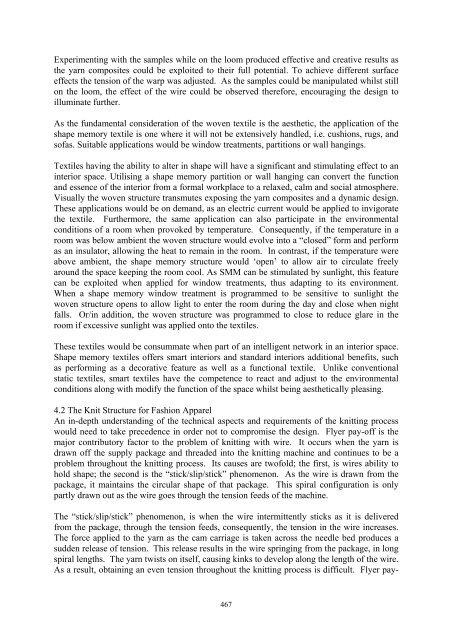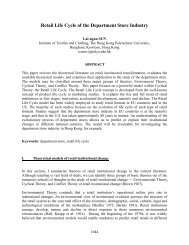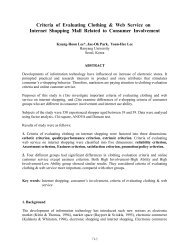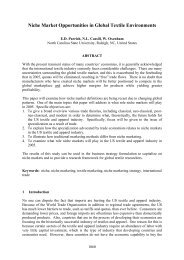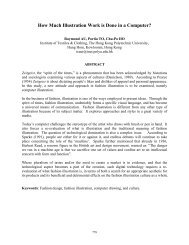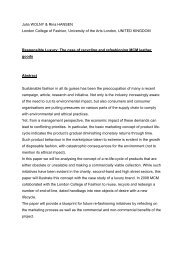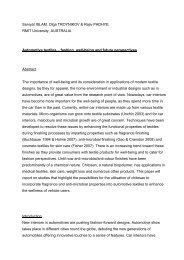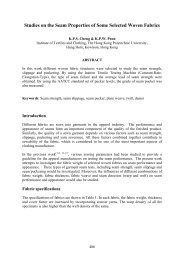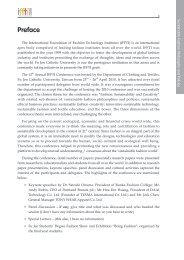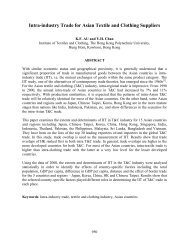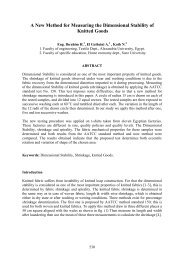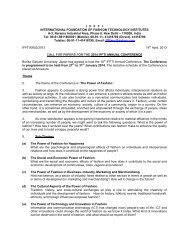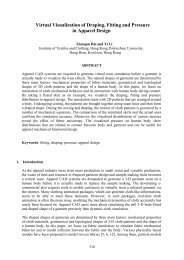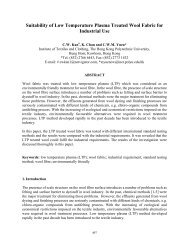The Concept of Aesthetic Intelligence of Textile Fabrics and their ...
The Concept of Aesthetic Intelligence of Textile Fabrics and their ...
The Concept of Aesthetic Intelligence of Textile Fabrics and their ...
You also want an ePaper? Increase the reach of your titles
YUMPU automatically turns print PDFs into web optimized ePapers that Google loves.
Experimenting with the samples while on the loom produced effective <strong>and</strong> creative results as<br />
the yarn composites could be exploited to <strong>their</strong> full potential. To achieve different surface<br />
effects the tension <strong>of</strong> the warp was adjusted. As the samples could be manipulated whilst still<br />
on the loom, the effect <strong>of</strong> the wire could be observed therefore, encouraging the design to<br />
illuminate further.<br />
As the fundamental consideration <strong>of</strong> the woven textile is the aesthetic, the application <strong>of</strong> the<br />
shape memory textile is one where it will not be extensively h<strong>and</strong>led, i.e. cushions, rugs, <strong>and</strong><br />
s<strong>of</strong>as. Suitable applications would be window treatments, partitions or wall hangings.<br />
<strong>Textile</strong>s having the ability to alter in shape will have a significant <strong>and</strong> stimulating effect to an<br />
interior space. Utilising a shape memory partition or wall hanging can convert the function<br />
<strong>and</strong> essence <strong>of</strong> the interior from a formal workplace to a relaxed, calm <strong>and</strong> social atmosphere.<br />
Visually the woven structure transmutes exposing the yarn composites <strong>and</strong> a dynamic design.<br />
<strong>The</strong>se applications would be on dem<strong>and</strong>, as an electric current would be applied to invigorate<br />
the textile. Furthermore, the same application can also participate in the environmental<br />
conditions <strong>of</strong> a room when provoked by temperature. Consequently, if the temperature in a<br />
room was below ambient the woven structure would evolve into a “closed” form <strong>and</strong> perform<br />
as an insulator, allowing the heat to remain in the room. In contrast, if the temperature were<br />
above ambient, the shape memory structure would ‘open’ to allow air to circulate freely<br />
around the space keeping the room cool. As SMM can be stimulated by sunlight, this feature<br />
can be exploited when applied for window treatments, thus adapting to its environment.<br />
When a shape memory window treatment is programmed to be sensitive to sunlight the<br />
woven structure opens to allow light to enter the room during the day <strong>and</strong> close when night<br />
falls. Or/in addition, the woven structure was programmed to close to reduce glare in the<br />
room if excessive sunlight was applied onto the textiles.<br />
<strong>The</strong>se textiles would be consummate when part <strong>of</strong> an intelligent network in an interior space.<br />
Shape memory textiles <strong>of</strong>fers smart interiors <strong>and</strong> st<strong>and</strong>ard interiors additional benefits, such<br />
as performing as a decorative feature as well as a functional textile. Unlike conventional<br />
static textiles, smart textiles have the competence to react <strong>and</strong> adjust to the environmental<br />
conditions along with modify the function <strong>of</strong> the space whilst being aesthetically pleasing.<br />
4.2 <strong>The</strong> Knit Structure for Fashion Apparel<br />
An in-depth underst<strong>and</strong>ing <strong>of</strong> the technical aspects <strong>and</strong> requirements <strong>of</strong> the knitting process<br />
would need to take precedence in order not to compromise the design. Flyer pay-<strong>of</strong>f is the<br />
major contributory factor to the problem <strong>of</strong> knitting with wire. It occurs when the yarn is<br />
drawn <strong>of</strong>f the supply package <strong>and</strong> threaded into the knitting machine <strong>and</strong> continues to be a<br />
problem throughout the knitting process. Its causes are tw<strong>of</strong>old; the first, is wires ability to<br />
hold shape; the second is the “stick/slip/stick” phenomenon. As the wire is drawn from the<br />
package, it maintains the circular shape <strong>of</strong> that package. This spiral configuration is only<br />
partly drawn out as the wire goes through the tension feeds <strong>of</strong> the machine.<br />
<strong>The</strong> “stick/slip/stick” phenomenon, is when the wire intermittently sticks as it is delivered<br />
from the package, through the tension feeds, consequently, the tension in the wire increases.<br />
<strong>The</strong> force applied to the yarn as the cam carriage is taken across the needle bed produces a<br />
sudden release <strong>of</strong> tension. This release results in the wire springing from the package, in long<br />
spiral lengths. <strong>The</strong> yarn twists on itself, causing kinks to develop along the length <strong>of</strong> the wire.<br />
As a result, obtaining an even tension throughout the knitting process is difficult. Flyer pay-<br />
467


